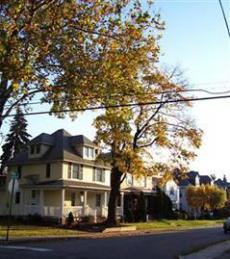Neighborhoods and Wards
 The city of Greensburg is currently composed of eight wards, most of which were formerly boroughs and are divided into several neighborhoods. Bunker Hill, now Fifth Ward, was merged into Greensburg in 1894. The name originated because of fights at the rowdy Bushfield Tavern in the early 1840s to mid-19th century that were compared to the Battle of Bunker Hill.
The city of Greensburg is currently composed of eight wards, most of which were formerly boroughs and are divided into several neighborhoods. Bunker Hill, now Fifth Ward, was merged into Greensburg in 1894. The name originated because of fights at the rowdy Bushfield Tavern in the early 1840s to mid-19th century that were compared to the Battle of Bunker Hill.
In 1905, Greensburg absorbed three adjacent boroughs, including Ludwick, now Sixth Ward, which was named for Ludwick Otterman, an early settler for whom the street is also named, as well as East Greensburg, now Seventh Ward, and Southeast Greensburg, unofficially known as Paradise (Eighth Ward). South Maple Avenue was originally named Kinderhook (Third Ward). Second Ward, located north of Downtown Greensburg, is the largest ward and includes the neighborhoods of Saybrook Village, Evergreen Hill, New Salem Acres, Country Club Meadows, Northmont, Devonshire Heights, Rose Fountain Farms and Academy Hill. Hilltop, a neighborhood in Eighth Ward, was originally settled by Italian immigrants and borders South Greensburg and Underwood on either side. First Ward features Chestnut Hill and Shuey Plan, and is also home to Seton Hill University. Other Greensburg neighborhoods include Eastern Estates, Underwood, Shogan and Hillcrest.
Eighth Ward was originally home to many Italian immigrants from Cercemaggiore, Italy. Today, the original Our Lady of Grace church, built by the masons from Italy, still stands although used as a residence. The Hilltop Social Club, founded by a few families who lived in the areas of Bierer, Margaret, White and Catherine Streets is also located here. Every year it has become a tradition for the firehall in the Eighth Ward to throw a carnival which includes bingo, amusement rides, and of course the famous Shuey Burgers.
Two neighborhoods have been designated as U.S. historic districts, the Greensburg Downtown Historic District and the Academy Hill Historic District. Also listed on the National Register of Historic Places are the Greensburg Railroad Station and Westmoreland County Courthouse.

